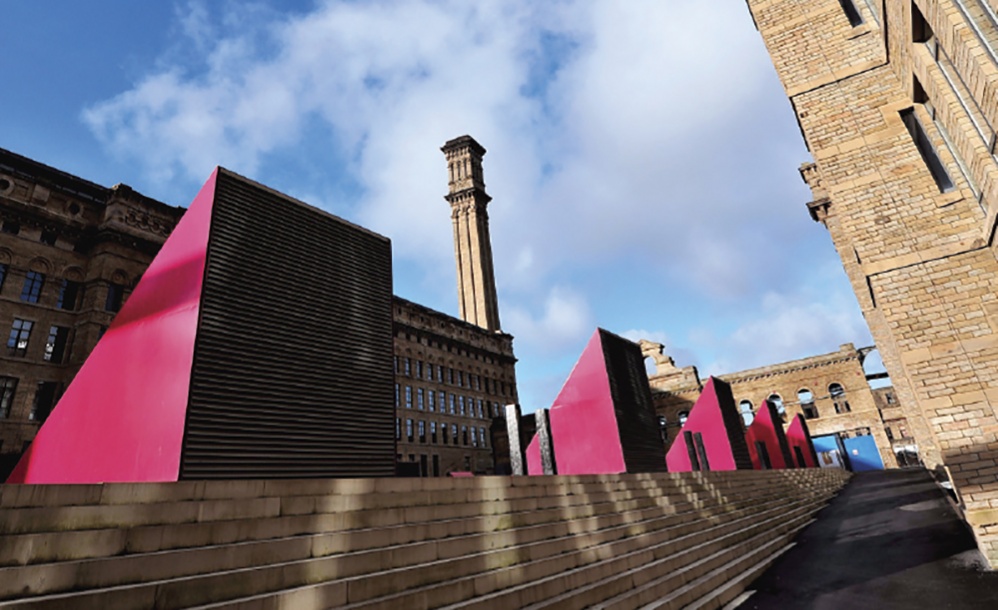The Reuse of Yorkshire's Old Mills

The cutting-edge pods that now populate the rooftop of Lister Mills in Bradford might seem like they have more in common with the space age than the textile age, but the architect behind them has actually woven in a clever thread linking the contemporary homes with the iconic landmark’s 19th century roots.
David Morley, who designed the eye-catching penthouse homes, took weaving as his starting point and inspiration, wrapping the curvilinear metal fabric into what looks like a plait to echo the warp and weft of traditional textiles.
‘It’s a beautiful yet simple feature which importantly commemorates the building’s heritage and evokes the spirit of Samuel Lister, who was himself a prolific inventor and lover of innovative design in his day,’ says Mark Latham, Regeneration Director of Urban Splash, which took on the mighty task of transforming Lister Mills from a dilapidated shell into a collection of covetable apartments and commercial units.
Samuel Lister was indeed an indefatigable inventor, holding the most patents in the UK during his lifetime, so it probably is safe to assume that he would have heartily approved of the roof pods on top of what is now called Velvet Mill, the second phase of the Lister Mills development, which also includes Silk Warehouse. The Grade-II listed mill complex he created – once the largest silk mill in the world – has dominated the Bradford skyline since it was built in 1838 but, before Urban Splash moved in, it was becoming less of a landmark and more of an eyesore.
‘It was in a totally dilapidated state when we took it on,’ says Mark. ‘But we immediately appreciated the beauty and grandeur of the canvas. We always knew it would take a long time to do it right, but we’re proud of how the buildings have been transformed.
‘We’re great believers in preservation and using sympathetic design techniques to bring a building back to life. Yorkshire is rich in such buildings and Lister Mills had an immediate appeal to us. It’s a very stark aesthetic contrast to one of our other most famous buildings in the region – Park Hill in Sheffield (a concrete Brutalist housing estate from the early 1960s) – but, nonetheless, each required the same level of passion and sensitivity.’ This meant retaining the exposed brick work, original cast iron columns and vaulted ceilings, while adding stretches of floor to ceiling glazing, splashes of contemporary colour and, of course, the zinc-clad rooftop penthouses with their eye-catching curved profiles and far-reaching views across the city to the hills beyond.
Lister Mills is just one of many Yorkshire mills that have been transformed in recent years, injecting new life through housing, retail, arts and heritage projects into what could easily have become the crumbling, dilapidated remnants of a once proud industry. They obviously offer enormous scope and space for development, but their sheer scale can also be a burden. The Lister Mills site, for instance, is as long and tall as Buckingham Palace, with a striking 250ft Italian campanile-style chimney thrown in for good measure. So, where do you do start when first faced with the enormity of the task ahead?
For John Gaunt, whose family has been connected to Sunny Bank Mills in Farsley, Leeds, since 1829, when his great-grandfather joined forces with a group of local businessmen to start scouring and scribbling cloth there, it started very simply with a quiet moment of contemplation.
‘We sold the textile trading business in April 2008 on the cusp of the recession and there was a moment when William (his cousin and fellow managing director) and I stood in the middle of an empty and strangely quiet Sunny Bank Mills wondering what we were doing and where to start,’ he says. ‘We were the generation that made the decision to end 150 years of textile activity and we were absolutely committed to regenerating the mills and giving them a sustainable and prosperous future.
‘From day one, we focused on getting jobs back. Sunny Bank has always been a hub for employment with more than 800 people employed at its Victorian peak. Modern working practices mean we will never return to that number, but we aim to attract more than 500 people and are well on the way with more than 350 people and 75 businesses here today.’ The original Sunny Bank textile mill was a hive of creative activity in its day and the Gaunts strive to retain that atmosphere by making culture and the arts an integral part of their vision. At its heart is a gallery, which promotes affordable work by local designer-makers and has a rolling exhibition programme that complements the installations, performances and concerts that are held within the wider mill space. It is, according to John, about creating a sustainable, supportive community.
‘There’s a lot of synergy between the businesses,’ he says, ‘whether it’s the 15 artists in the Spinning Mill studios or the digital creative companies. If you need a new sign for your business, a haircut, a new website, a photographer, you don’t need to go far. We work hard to create a harmonious mix of occupiers that will suit each other, as well as give Sunny Bank a sustainable future.’
Like most Yorkshire mills, Sunny Bank is very much a work in progress, with more renovations and transformations still to come. The Gaunts are currently opening up a space at the centre of the mill complex, connecting the woodland car park to the Old Combing, and Red Lane Mill to the 1912 Mill. ‘This is our biggest, most ambitious and most exciting project yet,’ says John. ‘It will create a much more obvious entrance, a 5,000 square foot green outdoor performance space and will reveal facades of the original mill buildings that have not been seen for more than a century.’
Further development is also still on the cards over in Halifax at Dean Clough, once the world’s largest carpet factory on a 20-acre site stretching for half a mile across the town and now one of the North’s leading commercial hubs. Home to more than 150 businesses which, together with the mill’s own private galleries, restaurants and theatre, have more than 4,000 employees, Dean Clough attracts more than 60,000 visitors a year. Next on its lengthy development tick-list is an ambitious project to transform one of the existing mill buildings into residential apartments in 2020 (watch this enormous space).
A key component of Dean Clough, and most other Yorkshire mill developments, is their pride in their shared heritage. Salts Mill in Saltaire, for instance, has a fascinating exhibition – People & Process – which tells its story through objects great and small, including a plate from the lavish opening banquet in 1853, to which Sir Titus Salt invited 2,440 workers and 1,310 guests. His original boardroom furniture is also on display, while a film about the history of the mill and the surrounding village plays in an adjoining room. The West Yorkshire mill is now a place for art, dining and shopping, with more than 1,000 employees across four floors, but it has clearly not forgotten its roots.
Armley Mills – now Leeds Industrial Museum – takes this one stage further by giving visitors a real blast from the past with collections of textile machinery, railway equipment and heavy engineering. It’s also home to one of the smallest 1920s cinemas in the world (it only has 24 seats); a tailoring gallery, which reveals how Leeds helped launch high street fashion through pioneers like John Barran, Joseph Hepworth and Montague Burton; textile galleries, with live demonstrations of spinning and weaving; and an impressive phalanx of steam engines.
Each mill presents a clear link with Yorkshire’s past, but what part can they play in shaping the county’s future? We go back to Lister Mills to find out what effect its regeneration is having on the continuing development of Bradford.
‘The area is rapidly changing and, hopefully, we are playing our part,’ says Mark. ‘Culturally, the place has erupted in recent years. The independent quarter with its bars, restaurants and co-working spaces has really made its presence felt; there’s Lister Park and Cartwright Hall, with its David Hockney gallery; and, of course, there’s the development of the Odeon as a new NEC venue to look forward to.
‘We hope Lister Mills will continue to inspire for generations to come. Given that it’s been loved and embraced for more than 150 years, I think it’s already stood the test of time. I hope future generations will keep on celebrating historic architecture like this, and the many others around Yorkshire.’
It’s a similar story in Farsley, where John and William Gaunt are leading the charge with their investment of time, money and hard graft at Sunny Bank. ‘Farsley has a fiercely independent spirit, which means it’s always fighting hard to prosper, whatever the challenges,’ says John. ‘I hope that by seeing us investing millions into Farsley, it gives others the confidence to do the same.’






